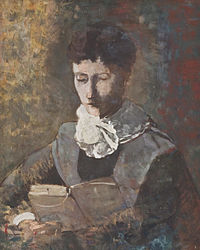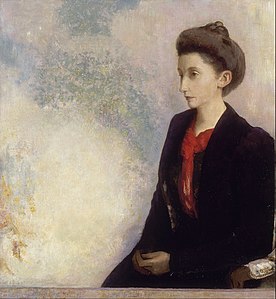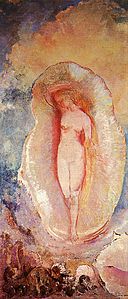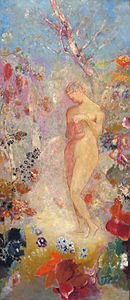Odilon Redon

Odilon Redon , actually Bertrand Redon (born April 22, 1840 in Bordeaux , † July 6, 1916 in Paris ), was a French graphic artist and painter of Symbolism and co-founder of the Société des Artistes Indépendants . The artist's work is divided into an early black and a (late) colored phase.
Life
Redon was born in Bordeaux as the second son of the wealthy landowner Bertrand Redon and his wife Marie Guerin. The father had bought the Chateau Peyre-Lebade winery in Médoc in 1835 (it became the property of Baron Edmond de Rothschild in 1979 ). His parents lived in Bordeaux and gave the baby to a wet nurse in Peyrelebade, a village near the estate, where he grew up with an old uncle , probably because of an epilepsy disease. As a boy he was almost exclusively interested in drawing . In 1855, at the age of 15, he took painting lessons in watercolor; In 1857 he met the evolutionary biologist Armand Clavaud (1828–1890). His interests were also in literature, the natural sciences and music. In both 1862 and 1864, at the request of his parents, he tried in vain to pass the entrance examination at the École des Beaux-Arts for the architecture class. In 1864 he went to Paris, where he visited the studio of Jean-Léon Gérôme , who taught at the École nationale supérieure des beaux-arts de Paris . Redon was not enthusiastic about the academic painting style of his teacher, who was known as a master of neoclassicism and as a salon painter . His first etchings in aquatint technique were under the influence of Rodolphe Bresdin , an artist who had visions and Redon with its mysteries made familiar.
At the Salon de Paris in 1868, the artists Gustave Courbet , Édouard Manet , Camille Pissarro and Jean-Baptiste Camille Corot , whom Redon admired, exhibited who were to serve as models for his own painting. In 1870/1871 Redon took part in the Franco-German War as an infantryman . He then moved completely to Paris, where he lived on an income that his parents' winery threw off. During this time he concentrated on the technique of charcoal drawing (fusains) . He participated intensively in the artistic life of the city, his literary interests were Gustave Flaubert , Charles Baudelaire and Edgar Allan Poe . Redon traveled extensively and studied Rembrandt's work in the Netherlands and that of Peter Paul Rubens in Flanders . He continued to spend the summer months in his parents' house, where he made a large number of charcoal drawings.
In the 1870s and 1880s, his "black" period, which includes his charcoal drawings, Redon treated literary, fantastic, but also Christian topics by placing them in a metaphysical context. He first turned to color in the late 1880s. Caliban , a monster from William Shakespeare's The Tempest , is often represented in his work, including around 1895–1900 in a small picture, The Sleep of Caliban , which is exhibited in the Musée d'Orsay .
Since 1878, he worked on, led by Henri Fantin-Latour , using the technique of lithography and could thus his Noirs ( "Black") mentioned drawings transferred to stone and printed in editions. Lithograph series appeared in quick succession, depicting the artist's dream world: 1879 Dans le Rêve , 1882 Á Edgar Poe , 1883 Les Origines , 1885 Hommage à Goya and 1886 Le Nuit . The three albums that deal with Flaubert's The Temptation of Saint Anthony (1888, 1889, 1896) make up about a quarter of his lithographic work.
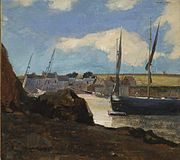
In 1880 he married Camille Fargue, who came from the island of Bourbon . The marriage had two sons, the elder of whom died in the sixth month. In 1882, the influential critic Emile Hennequin (1859-1888) became aware of Redon. In a newspaper article he defended his charcoal drawings, which were shown at an exhibition in the office of the daily newspaper Le Gaulois and which were violently attacked by the public. With the journalistic support of Hennequin and Joris-Karl Huysmans , Redon became known in Paris society.
In 1884 he co-founded the Société des Artistes Indépendants and the Salon des Indépendants in Paris and was for a time vice chairman of the Société. Nonetheless, at the invitation of Armand Guillaumin , he took part in the last exhibition of the “Impressionist Group” in 1886, as he also appreciated Georges Seurat and Paul Gauguin . Redon found the painting of the Impressionists ultimately restrictive.
Around 1885 the young literary movement of the "Symbolists" arose in Paris. Influenced by Charles Baudelaire , they wanted to evade the naturalism of Victor Hugo and Émile Zola . a. Paul Verlaine (* 1844), Stéphane Mallarmé (* 1842) and Auguste de Villiers de L'Isle-Adam (* 1838) were members. The poets who wanted to create their own literary world by including "[...] dream images, hallucinations, memories and imaginary creations" - "because all of these play a role in life and even determine [...]" - saw the reluctant one Redon as one of their own. However, Redon could do little with her rules, theories and the manifesto Le symbolisme published by Jean Moréas in 1886 . In 1913 he was represented with works on the legendary Armory Show in New York .
plant
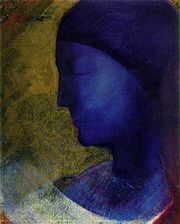
In his “black phase”, Redon devoted himself to the human unconscious with its fears and nightmares in charcoal drawings and prints , creating haunting, sometimes eerie works. Particularly well-known are the drawing of a black raven, who appears as a messenger of death, and the depiction of a large, multi-legged spider with a smiling face on its black haired body. Another important topic of the so-called "nightmare pictures" are large eyes or eyeballs that appear to be looking at the viewer. Exemplary is the drawing of a single eye that functions as a hot air balloon , as well as an egg with a face that, squeezed into an egg cup, represents a space anxiety dream.
In his second creative phase, Redon broke completely with his "black" works and began to depict motifs from mythology as well as a fantastic natural history in bright colors and strongly abstracted in paintings of great color . The image of a quadriga floating in colored clouds and the stylized depictions of jellyfish, mussels and other marine animals are well known. These multi-layered images of a world of ideas live through the depth of the iridescent mist of color.
Although created at the same time as the Impressionist painters , Redon's work is completely independent and different. His pictures precede Expressionism and Surrealism in content and form . Many later artists therefore referred to Redon.
In 1964, his works were shown at the documenta III in Kassel in the famous hand drawings department .
Works (selection)
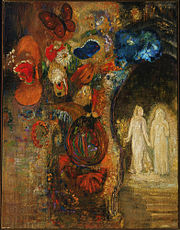
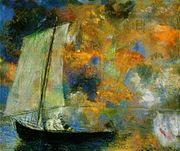
- 1866: Rose dans un vase (Musée national des beaux-arts, Algiers )
- 1867: Mon portrait , oil on wood ( Musée d'Orsay , Paris)
- 1868: Roland à Roncevaux (Musée des Beaux-Arts, Bordeaux )
- 1878: Eye-Balloon ("Augen-Balloon", 1878; Museum of Modern Art , New York)
- 1878: Esprit gardien des eaux
- 1880: Autoportrait ("Self-Portrait"; Musée d'Orsay , Paris)
- 1881: L'Araignée qui pleure ("The Weeping Spider"), charcoal drawing (private collection, Netherlands)
- 1881: L'Homme cactus ("The Cactus Man"; Ian Woodner Family Collection, New York)
- 1881: Caliban ( Musée d'Orsay , Paris)
- 1882: Le Port de Morgat ("The Port of Morgat"), oil on canvas, 27 × 30 cm ( Dallas Museum of Art )
- 1882: Le Corbeau , charcoal drawing ( National Gallery of Canada , Ottawa )
- 1885: Le Fou ou La Folie. Tête coiffée d'un bonnet , charcoal drawing ( Musée d'Orsay , Paris)
- 1890: Les Yeux Clos ( Musée d'Orsay , Paris)
- 1890: Village breton ( National Gallery of Art , Washington)
- 1890: Vieillard ailé barbu , pastel ( Musée d'Orsay , Paris)
- 1890: Esprit de la forêt (private collection)
- around 1890–1895: Dame aux fleurs , oil on canvas ( Honolulu Museum of Art )
- 1890s: Les arbres , charcoal drawing, 50.2 × 37.5 cm ( Museum of Fine Arts, Houston )
- 1890s: Apparition , oil on canvas, 50 × 65 cm ( Princeton University Art Museum)
- 1892: La Cellule d'or , oil, gold and chalk on paper, 30.1 × 24.7 cm ( British Museum , London)
- 1892: Saint Jean , pastel and charcoal (private collection)
- around 1893–1894: L'Enfant devant l'aurore boréale , pastel on paper, 27 × 26.8 cm ( Musée des beaux-arts , Dijon)
- 1896: Le Christ au sacré coeur
- around 1898 (or around 1914): Le Cyklope ("The Cyclops"), oil on cardboard ( Kröller-Müller Museum , Otterlo , Netherlands)
- around 1900: Vision dans les nuages , oil on canvas, 83 × 67 cm ( Musée des beaux-arts , Dijon)
- 1900: Baronne Robert de Domecy , oil on canvas, 74 × 68 cm ( Musée d'Orsay , Paris)
- 1900–1905: Ophélie , pastel on paper (Dian Woodner Collection, New York)
- 1900s: Vase aux fleurs , pastel, 46.2 × 38.7 cm ( Princeton University Art Museum)
- 1901: Arbres sur un fond jaune , oil, tempera , charcoal and pastel on canvas, 24.7 × 17.3 cm ( Musée d'Orsay , Paris)
- 1903: Nuages fleuris , pastel mixed media, 44.5 × 54.2 cm ( Chicago Art Institute )
- 1904: Female silhouette in the midst of flowers (private collection)
- around 1905: Initiation à l'étude. Deux jeunes femmes , oil on canvas, 93 × 65 cm ( Dallas Museum of Art )
- around 1905: Le Char d'Apollon , 60 × 73 cm ("The Chariot of Apollo"; Clemens Sels Museum , Neuss )
- 1905: Christ en croix ( Musée d'Orsay , Paris)
- around 1905–1908: Ophélie parmi les fleurs ( National Gallery , London)
- 1905–1909: Vase with poppies , oil on canvas, 54.9 × 65.5 cm (private collection)
- around 1906: Le Pavot Rouge ( Musée d'Orsay , Paris)
- 1906–1907: Le Bouddha , pastel on colored paper, 90 × 73 cm ( Musée d'Orsay , Paris)
- 1907: Pégase sur son roc , oil on parqueted cardboard
- 1909: Fleurs , oil on canvas, 81 × 100 cm (private collection)
- around 1909–1910: Roger et Angélique ( Kröller-Müller Museum , Otterlo , Netherlands)
- around 1910: Crucifixion ("Crucifixion"; Musée d'Orsay , Paris)
- around 1910: Papillons ("Butterflies"), oil on canvas, 73.9 × 54.9 cm ( Museum of Modern Art , New York)
- 1910: Portrait de Violette Heymann , pastel, 72 × 92 cm ( Cleveland Museum of Art )
- around 1910–1912: Saint Sebastian , oil on canvas, 144 × 62.5 cm ( National Gallery of Art , Washington)
- around 1911: The turquoise vase , oil on canvas, 65 × 50 cm (private collection)
- 1912: La Coquille , pastel ( Musée d'Orsay , Paris)
- 1912: La Naissance de Vénus , oil on canvas ( Museum of Modern Art , New York)
- around 1914: Hommage à Léonard de Vinci , pastel ( Stedelijk Museum , Amsterdam)
- 1914: Pandore , oil on canvas, 143.5 × 62.2 cm ( Metropolitan Museum of Art , New York)
gallery
Baronne Robert de Domecy , oil on canvas, 1900 ( Musée d'Orsay , Paris)
Initiation à l'étude. Deux jeunes femmes , oil on canvas, 1905 ( Dallas Museum of Art )
Le Bouddha , pastel on colored paper, 1906–1907 ( Musée d'Orsay , Paris)
Saint Sebastian , oil on canvas, around 1910–1912 ( National Gallery of Art , Washington)
La Naissance de Vénus , oil on canvas, 1912 ( Museum of Modern Art , New York)
Pandore , oil on canvas, 1914 ( Metropolitan Museum of Art , New York)

Printing technology
- 1879: Dans le rêve , ten lithographic sheets in album form (Lemercier, Paris; 25 copies); therein u. a. Divine Omniscience
- 1882: À Edgar Poe , six lithographs and a frontispiece (Lemercier, Paris; 50 copies)
- 1883: Les Origines , eight lithographs and a frontispiece (Lemercier, Paris; 25 copies)
- 1885: Hommage à Goya , six lithographs (PLemercier, Paris; 50 copies)
- 1886: La Nuit , ten lithographs (Lemercier, Paris; 50 copies)
- 1887: L'araignée, elle sourit, les yeux levés , lithograph (Lemercier, Paris; Fonds Musée d'Orsay, Département des arts graphiques des Musée du Louvre )
- 1888: La Tentation de saint Antoine , ten lithographs (Becquet, Paris) and a frontispiece, text by Gustave Flaubert (Deman, Brussels; 58 copies)
- 1889: À Gustave Flaubert , second series, six lithographs and a frontispiece (Becquet, Paris; 60 copies)
literature
- Octavia Christ: Odilon Redon. Visions of an artist poet. Berlin 1994.
- Dario Gamboni: The Brush and the Pen: Odilon Redon and Literature. Chicago 2011 (trend-setting analysis of the work with the help of sociology and literary studies).
- Peter Metz: Introduction. in: Painting of the West. A collection of pictures from early Christian to contemporary painting. FA Herbig publishing house, Berlin-Grunewald 1955.
- Margret Stuffmann (Ed.): Odilon Redon. Like a dream. Hatje Cantz Verlag, Ostfildern 2007, ISBN 978-3-7757-1893-6 .
Exhibition catalogs
- Douglas W. Druick (Ed.): Odilon Redon, Prince of Dreams. Abrams, New York 1994 (joint exhibition catalog of the Art Institute of Chicago , Van Gogh Museum , Amsterdam, and Royal Academy of Arts , London).
- Jodi Hauptman: Beyond the Visible: The Art of Odilon Redon. New York 2005 ( Museum of Modern Art exhibition catalog , October 30, 2005 - January 23, 2006).
- Herwig Todts: Goya, Redon, Ensor: Grotesque Paintings and Drawings. Tielt 2009 (exhibition catalog of the Koninklijk Museum voor Schone Kunsten , Antwerp, 14 March - 14 June 2009).
- Raphaël Bouvier (Ed.): Odilon Redon. Hatje Cantz Verlag, Ostfildern 2014 (exhibition catalog of the Fondation Beyeler , Riehen BS , February 2 - May 18, 2014).
Web links
- Literature by and about Odilon Redon in the catalog of the German National Library
- Works by Odilon Redon at Zeno.org .
- Museums, galleries and further links at artcyclopedia
- Odilon Redon on artnet
- Biography ( memento of January 24, 2004 in the Internet Archive ) (English)
- Materials by and about Odilon Redon in the documenta archive
- Alexandra Matzner on the Redon exhibition at the Fondation Beyeler, work analysis and succession
Individual evidence
- ^ City of Bordeaux, excerpt from the register of birth records for the year 1840, folder of the Legion of Honor of Odilon Redon , Base Léonore
- ↑ Alexandra Matzner on "Odilon Redon" in the Fondation Beyeler
- ^ Redon: Works in the Musée d'Orsay, Paris
- ↑ Alexandra Matzner on Gérôme in the Musée d'Orsay
- ↑ Ann H. Sievers, Linda D. Muehlig et al .: Master drawings from the Smith College Museum of Art. Hudson Hills 2001, pp. 188 ff, ISBN 978-1-55595-183-2 .
- ↑ Caliban. Musée d'Orsay, accessed October 1, 2012 .
- ^ Jean-Claude Lemagny, in: Kindlers Malereilexikon , vol. 5. Kindler, Zurich 1964, p. 35.
- ^ Paul Adam: La Presse et Symbolisme. In: Le Symboliste , October 7, 1886, quoted from: John Rewald: From Van Gogh to Gauguin. DuMont, Cologne 1987, ISBN 3-7701-2147-3 , p. 83.
| personal data | |
|---|---|
| SURNAME | Redon, Odilon |
| ALTERNATIVE NAMES | Redon, Bertrand-Jean (maiden name) |
| BRIEF DESCRIPTION | French symbolism painter |
| DATE OF BIRTH | April 22, 1840 |
| PLACE OF BIRTH | Bordeaux |
| DATE OF DEATH | July 6, 1916 |
| Place of death | Paris |




